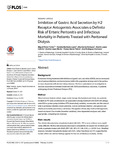Inhibition of gastric acid secretion by H2 receptor antagonists associates a definite risk of enteric peritonitis and infectious mortality in patients treated with peritoneal dialysis

Ver/
Use este enlace para citar
http://hdl.handle.net/2183/21490Coleccións
- GI-FENM - Artigos [109]
Metadatos
Mostrar o rexistro completo do ítemTítulo
Inhibition of gastric acid secretion by H2 receptor antagonists associates a definite risk of enteric peritonitis and infectious mortality in patients treated with peritoneal dialysisAutor(es)
Data
2016-02-12Cita bibliográfica
Pérez-Fontán M, Machado Lopez D, García Enriquez A, López-Calvño B, López-Muñiz A, García Falcón T, et al. Inhibition of gastric acid secretion by H2 receptor antagonists associates a definite risk of enteric peritonitis and infectious mortality in patients treated with peritoneal dialysis. PLoS ONE. 2016;11(2): e0148806
Resumo
[Abstract] Background. Evidences linking treatment with inhibitors of gastric acid secretion (IGAS) and an increased risk of serious infections are inconclusive, both in the population at large and in the particular case of patients with chronic kidney disease. We have undertaken an investigation to disclose associations between treatment with IGAS and infectious outcomes, in patients undergoing chronic Peritoneal Dialysis (PD).
Method. Observational, historic cohort, single center design. Six hundred and ninety-one patients incident on PD were scrutinized for an association among treatment with IGAS (H2 antagonists H2A or proton pump inhibitors PPI) (main study variable), on one side, and the risks of enteric peritoneal infection (main outcome), overall peritoneal infection, and general and infectious mortality (secondary outcomes). We applied a three-step multivariate approach, based on classic Cox models (baseline variables), time-dependent analyses and, when appropriate, competing risk analyses.
Main results. The clinical characteristics of patients treated with H2A, PPI or none of these were significantly different. Multivariate analyses disclosed a consistently increased risk of enteric peritonitis in patients treated with IGAS (RR 1.65, 95% CI 1.08–2.55, p = 0.018, Cox). Stratified analysis indicated that patients treated with H2A, rather than those on PPI, supported the burden of this risk. Similar findings applied for the risk of infectious mortality. On the contrary, we were not able to detect any association among the study variables, on one side, and the general risks of peritonitis or mortality, on the other.
Conclusions. Treatment with IGAS associates increased incidences of enteric peritonitis and infectious mortality, among patients on chronic PD. The association is clear in the case of H2A but less consistent in the case of PPI. Our results support the convenience of preferring PPI to H2A, for gastric acid inhibition in PD patients.
Palabras chave
Enterobacteriaceae infections
Follow-up studies
Gastric acid
Histamine H2 antagonists
Kaplan-Meier estimate
Longitudinal studies
Multivariate analysis
Peritoneal dialysis
Peritonitis
Proportional Hazards models
Renal insufficiency, chronic
Follow-up studies
Gastric acid
Histamine H2 antagonists
Kaplan-Meier estimate
Longitudinal studies
Multivariate analysis
Peritoneal dialysis
Peritonitis
Proportional Hazards models
Renal insufficiency, chronic
Versión do editor
Dereitos
Atribución 3.0 España
ISSN
1932-6203






